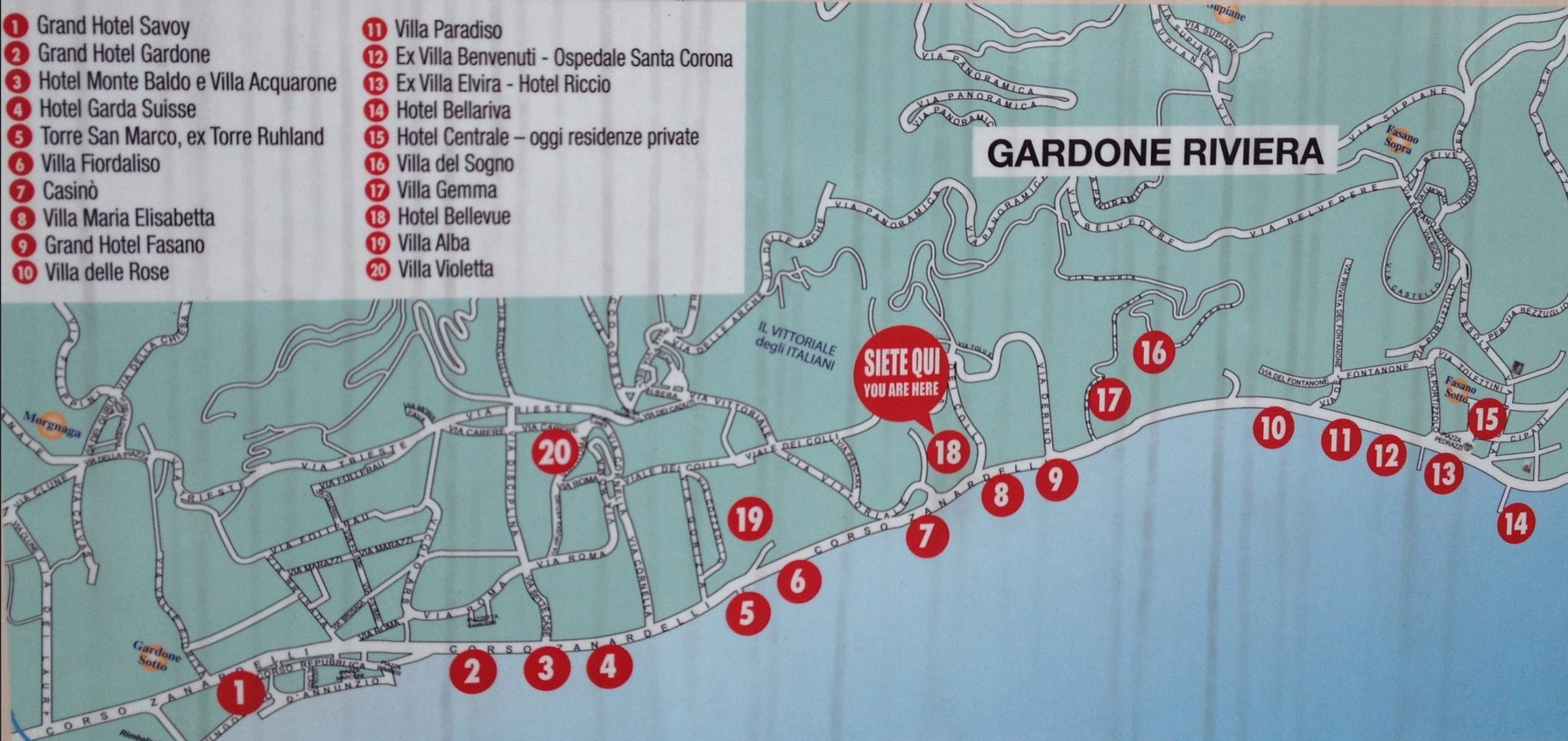THE END OF GARDONE’S GOLDEN AGE
The outbreak of the First World War marked the end of Gardone’s Belle Epoque. It must be noted at this stage that Germans formed the majority of the population of Gardone. The fact that Germans and Austrians stood on the opposite side in the conflict lead to nationalisation of the properties and their subsequent sale at auctions. One of such auctions lead to the split and sale of the Ruhland Estate. Villa Alba and Torre Ruhland were purchased by Gabriele D’Annunzio, an Italian pilot, poet, playwright, novelist and Mussolini’s friend, passionate about fascist ideology. D’Annunzio remodelled Torre Ruhland in resemblance of a medieval fortification structure, whose style remained unchanged to this day. D’Annunzio also bought the Carganacco estate from the descendants of Luigi Wimmer, where he created an impressive historical complex of Il Vittoriale to awaken the national Italian spirit and bring back the memory, and perhaps restoration, of the great Roman Empire. The smaller villa was purchased at the same auction by Count Turati.

Image: tanksandtrenches.wordpress.com
In 1918, after several tumultuous years of the war, the villa was, yet again, expropriated and nationalised with the decree of the 24th of January of the same year. The building was referred to as Villa Turrati, the name associated with an Italian aristocrat and professor of etymology Emilio Turati, who acquired the villa in 1920. He died in Gardone Riviera in 1938.
Emilio’s father, count Hercules (or Ercoe) Turati (1829-1881) – a Milanese banker and an ornithologist by interest. Together with his brother Ernesto, he amassed a collection of around 20,000 specimen of birds and their nests. His collection included a very rare specimen of an extinct bird Pinguinus Impennis, a species inhabiting rocky coasts of the cooler regions of the globe. After his death, the collection was donated (or sold) by the heirs of the estate to the Museum of Natural History in Milan.
The count’s brother, Vittorio was known for his pioneering inventions in photography such as the shade printing technique referred to as Sincroma or Synchromie. As previously mentioned, Emilio Turati bought the villa, possibly with the proceeds from the sale of his father’s collection.

Emilio Turati
Image: Portraits de Lepidopteristes. Second Series. in Etudes de Lepidopterologie Comparee by Charles Oberthur Fascicule X. 1915
The Turati family was a Milanese merchant family specialising in the trade of cotton and it is commonly known that Milan has been a European hub of the textile and fashion industry for centuries. The merchants, thanks to their wealth and influence, were quickly awarded an aristocratic title. The Turati family, just like the Tucher family of Malta, grew rapidly and diversified their commercial portfolio. One of those fields was banking and it was Hercules that became associated with this branch of the family’s business. However, there is no direct evidence that Hercules was in fact an official banker. He was certainly involved in the money lending business and this is probably why he may have been associated with the banking sector.
Emilio inherited a substantial property portfolio from his father, including Palazzio Emilio Turati, an impressive residence in the centre of Milan. The date of completion of the construction of the building, i.e. 1880, indicates that it was Hercules who funded the project, not Emilio, who at that time would have only been 22 years of age.
In the twenties of the 19th century, Gardone became a popular destination among artists. Amongst many, it was favoured by the painter Gregorio Sciltiano and the sculptor Francesco Messina. The town was also visited by Sir Winston Churchill, who spent some time in there after the war. One of the most notable attractions of the town is the Vittoriale complex, the construction of which was initiated by D’Annunzio, who commissioned Giancarlo Maroni to run the project in 1923. Works continued after D’Annunzio’s death. The enclosed 9 hectare estate, which also housed the ancient Cargnacco Villa (Luigi Wimmer’s residence and later that of Ernst Thode, the art critic), became known for its unique collection of artefacts compiled by D’Annunzio. Among many others, it included the Puglia ship, Mas 96 – a torpedo speedboat used for sinking vessels, Viribus Unitis – an Austrian ironclad, the airplane famed for its flight over Vienna on the 9th of August 1918, Isotta Fraschini and Fiat Torpedo. The writer also built an amphitheatre, which could house 1500 spectators, but it seems that the real gem of the estate was Schifamondo, the museum residence, which D’Annunzio never actually lived in, having chosen Villa Cargnacco (which he called Prioria) for his house.

Il Vittoriale degli Italiani, Gardone Riviera
Image: guidaturisticabresciaiseogarda.it

